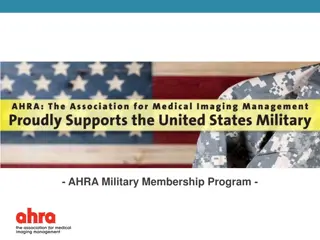Wake Island: Strategic Importance and Military Defense in World War II
Wake Island, located in the Northern Pacific Ocean, played a crucial role in World War II as a strategic outpost for both the United States and Japan. The island's military significance was highlighted by its defensive capabilities, long-range reconnaissance opportunities, and potential for offensive operations. The construction of barracks, fortifications, and an airfield transformed Wake Island into a formidable military garrison, defended by Marine and civilian personnel. Commander Winfield S. Cunningham and Major James Devereux were commendable leaders during the defense of Wake Island, receiving honors for their exemplary service.
Download Presentation

Please find below an Image/Link to download the presentation.
The content on the website is provided AS IS for your information and personal use only. It may not be sold, licensed, or shared on other websites without obtaining consent from the author.If you encounter any issues during the download, it is possible that the publisher has removed the file from their server.
You are allowed to download the files provided on this website for personal or commercial use, subject to the condition that they are used lawfully. All files are the property of their respective owners.
The content on the website is provided AS IS for your information and personal use only. It may not be sold, licensed, or shared on other websites without obtaining consent from the author.
E N D
Presentation Transcript
By: John Ferraraccio Dr. Harry Butowsky HIST 387
Wake Island: Location Northern Pacific Ocean 2004 Nautical miles from Hawaii 1029 Nautical Miles from Midway 1723 Nautical Miles from Tokyo
Wake Island: Characteristics V-Shaped atoll 2.85 sq. miles Composed of three islands: Wake Peale Wilkes 12 miles of defendable coastline 21 miles of total coastline
Wake Island: Military Importance The location of Wake Island provided for a strategic location for both the United States and the Japanese. It was recognized that if war broke out between Japan and the United States, Wake could: provide for an defensive outpost enable long range reconnaissance deep into enemy territory enable the disruption of shipping serve as staging ground for offensive operations be utilized as an emergency air station
Wake Island: Military Garrison August 1941, Marine and civilian workers began to construct barracks, defensive fortifications, and an airfield. All construction was conducted under the highest priority Wake Island was soon transformed from a desolate expanse to a formidable military garrison. Four 3-inch antiaircraft batteries Three 5-inch seacoast batteries Appropriate automatic weapons One SCR-268 fire-control radar, and one SCR-270B search radar 12 new F4F-3 (Grumman Wildcat) fighters The 1stMarine Defense Battalion and VMF- 211 were assigned to the defense of Wake. It is considered essential that the construction work now in progress on Wake be proceeded with and that the eventuality of war should not interrupt it. -Major James P. S. Devereux
Wake Island: The Defenders Commander Winfield S. Cunningham Officer in Charge, Naval Activities Wake Island Assumed command of Wake Island on November 28, 1941 Received the Navy Cross for his leadership during the defense of Wake
Wake Island: The Defenders Major James Devereux Commanding Officer of the 1st Defense Battalion 15 officers and 444 enlisted men Received the Navy Cross for his leadership during the defense of Wake Island
Wake Island: The Defenders Major Paul A. Putnam Commanding Officer of Marine Fighting Squadron 211 A "model of strong nerves and the will to fight" Received the Navy Cross for his heroism during the defense of Wake Island
Wake Island: The Attackers Rear Admiral Sadamichi Kajioka Commander, Wake Island Invasion Force 2,500 soldiers of the Imperial Special Landing Force (both landing attempts) 3 light cruisers 6 destroyers 2 patrol boats 2 transports 2 carriers (second landing attempt)
Wake Island: The Attack Begins At 0650 on December 8 (December 7th Pearl Harbor time), 1941, a call to arms rang out across Wake Island. This was in response to receiving coded messages indicating that Pearl Harbor was under attack. At approximately 1200, the first Japanese air attack began. Thirty-six Japanese long-range bombers from Roi sought to inflict a devastating first blow to the defenders of Wake- and indeed they did. Eight out of the twelve Marine fighters were knock out of flight operations, the airstrip was severely damaged, andVMF- 211 had sustained nearly sixty percent causalities . Air attacks of comparable size and magnitude continued for three more days, but the defenders of Wake grew smart of the Japanese tactics and employed their defensive fortifications accordingly. This resulted in limited Japanese successes.
Wake Island: First Invasion Attempt Under the assumption that most defensive fortifications on Wake had been destroyed by the proceeding aerial bombardment and that there would be only be minimal resistance from the few, demoralized defenders remaining on the island, Admiral Kajioka slated the invasion for December 10, 1941. But, due to ingenious camouflaging techniques and displacement of shore batteries, formidable defensives still remained intact on Wake. This underestimation in addition to the dogged fighting of the 1st Maine Defense Battalion, civilian contractors, and remaining VMF-211 fighters resulted in the Japanese landing parties being handily defeated and forced to retreat back into the sea and subsequently away from Wake. THIS WAS THE FIRST JAPANENESE DEFEAT OF WORLD WAR II!
Wake Island: Second Invasion Attempt Following the defeat of the first invasion attempt, long range bombers resumed daily bombing runs on Wake. Although the desired physical effect was not reached, the bombers began to wear down Wake s defenders. After regrouping and reorganizing, Admiral Kajioka scheduled the second invasion force to land December 23, 1941. This force was composed of roughly the same components as the first invasion force, but with the addition of two carriers which were dispatched following the attack on Pearl Harbor, two patrol boats, and an additional 1,500 Imperial Japanese Marines. Following a heavy pre-invasion bombardment, the landings began at 0235. The defenders remaining on Wake fought with tenacity and determination throughout the night and early morning hours, but despite their defiant spirit and efforts, the defense was futile. By mid afternoon, due to the sheer size of the Japanese invasion force, the Wake garrison was forced to surrender.
Wake Island: The Aftermath Although the Japanese succeeded in defeating the military garrison at Wake, it was not for a small cost Japanese losses exceeded 700 confirmed killed, with some estimates of actual killed exceeding 900 Four destroyers were sunk Two Patrol Boats were destroyed At minimal twenty aircraft shot down While the gallant effort displayed by those left to defend Wake had taken a hefty toll on the Japanese, the defenders suffered only a minimal loss of life. Only fifty-two U.S. military personnel were killed during the entire fifteen day Japanese onslaught, with nearly half killed in the first day alone. Seventy civilian contractors were also killed With the exception of 98 men selected to remain on Wake and serve as manual labors, the rest of the survivors were crammed onto transport ships and sent to prisoner of war camps throughout the south pacific and China. Captain Henry T. Elrod (seen at right), VMF-211's executive officer, distinguished himself both in the air and in the ground fighting at Wake, with deeds which earned him a posthumous Medal of Honor. He is also credited with shooting down two of the twenty-or-so Japanese Zeros .
Wake Island: Relief Effort Shortly after the attack on Pearl Harbor plans were being drawn up to relieve or reinforce Wake. By December 10, plans had been finalized for a reinforcement sortie to Wake. The mission to Wake was assigned to Task Force 14. Task Force 14 was composed of the carrier Saratoga, three heavy cruisers, nine destroyers, a seaplane tender, and a fleet of oil tankers. By December 13, the task force was ready-relief seemed to be on the way to wake. But, after conflicting reports surround the current status of the island as well as the questionable strength of Japanese forces in the area, Task Force 14 was ordered to return to Pearl Harbor and abort the relief mission.
Wake Island: War Crimes Aircraft from the USS Yorktown raided Wake on October 5, 1943. Fearing an invasion, Rear Admiral Shigematsu Sakaibara ordered the execution of the 98 laborers who still remained on Wake since its surrender. All of the prisoners were blindfolded and subsequently executed with machine guns. An unknown prisoner managed to escape the pending massacre. This prisoner eluded capture long enough to return to the sight of the executions and carved the message 98 US PW 5-10-43 on a large coral rock near where the victims had been hastily buried in a mass grave When he was finally recaptured, Sakaibara personally beheaded him with a Katana. After the war, Sakaibara and his subordinate, Lieutenant-Commander Tachibana, were sentenced to hang for this massacre.
Wake Island: The Alamo of the Pacific During December 1941, the stubborn defense of Wake by less than 450 Marines galvanized not only the American public but their comrades in arms. In days of disaster then, as of uncertainty later, the thought of Wake and its defenders encouraged Marines to hang on longer, and to fight more resolutely. Small in time and numbers though the action was by comparison with Guadalcanal or the other great battles to come, Wake will never be forgotten. To my mind, in addition to the obvious military lessons which may be drawn from any battle, be it victory or defeat, the defense of Wake points up two soldierly characteristics which may well be remembered by Marines. These are military adaptability, and the realization that, first and always one must be prepared to face ultimate close ground combat with the enemy. The officers and men of the 1st Defense Battalion on Wake were artillerymen of a highly specialized type; those of VMF-211 were aviation technicians. neither group let its specialized training or background prevent it from fighting courageously and well as basic infantry when the chips were down. Despite its specialization, each group did the best it could with what it had. These capabilities and attributes, I submit, should characterize Marines now as they characterized those Marines on Wake, who, though they were outnumbers and eventually overwhelmed, were never outfought. A.A. VANDEGRIFT General, U.S. Marine Corps Commandant of the Marine Corps
Bibliography Lieutenant Colonel R.D. Heinl, Jr., USMC. " Marines in World War II Historical Monograph: The Defense of Wake." Historical Section, Division of Public Information Headquarters, U.S. Marine Corps;1947. http://www.ibiblio.org/hyperwar/USMC/USMC-M-Wake.html (accessed 17 September 2011). Eagle Speak. "Sunday Shit History: The Heroes of Wake Island." Last Modified 13 December 2007. http://www.eaglespeak.us/2007/12/sunday-ship-history-heroes-of-wake.html (Accessed 17 September 2011). Olive Drab. "Wake Island: 1941." Last modified; 11 January 2011. http://www.olive- drab.com/od_history_ww2_ops_battles_1941wake.php.\ (Accessed 17 September 2011). Bill Sloan, Given Up for Dead. (New York: Bantam Books; 2003) Robert J. Cressman, A Magnificent Fight: Marines in the Battle for Wake Island: Marines in World War II (Commemorative Series) (United States Government Printing; 1993). http://www.militaryphotos.net/forums/showthread.php?177315-Battle-of-Wake-Island-Alamo-of-the-Pacific http://www.nps.gov/history/history/online_books/npswapa/extcontent/usmc/pcn-190-003119-00/sec2.htm http://militaryhistory.about.com/od/worldwari1/p/wakeisland.htm http://www.newworldencyclopedia.org/entry/Wake_Island























